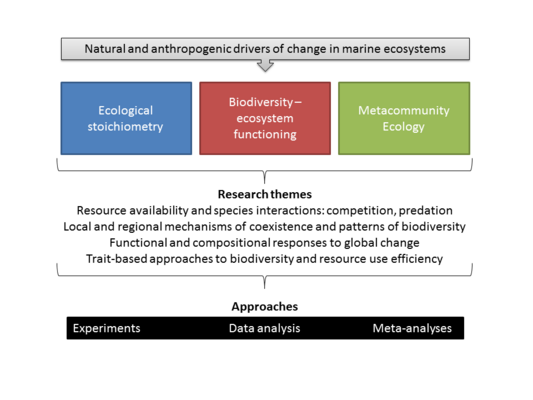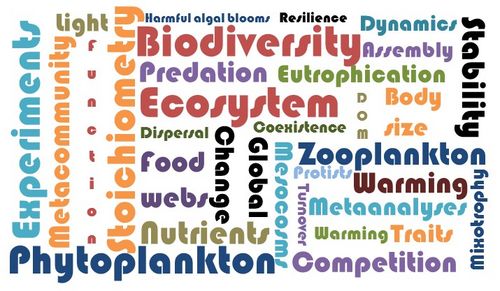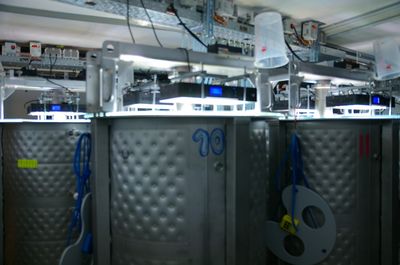Current Projects
Collaborative Projects
DynaSym: Density-dependent symbiosis in planktonic systems (2024-2028)
ACTNOW: Advancing understanding of Cumulative Impacts on European marine biodiversity, ecosystem functions and services for human wellbeing (2023-2027)
AQUACOSM-Plus: MethanTrons (2023)
DynaCom II: Spatial community ecology in highly dynamic landscapes: from island biogeography to metaecosystems (2022-2024)
AQUACOSM-Plus: Fluctotrons (2022)
AQUACOSM-Plus: SupOpTrons (2022)
DynaCom: Spatial community ecology in highly dynamic landscapes: from island biogeography to metaecosystems (2019-2021)
DynaTrait II: Flexibility matters: Interplay between trait diversity and ecological dynamics using aquatic communities as model systems (2018-2024)
POSER: POpulation Shift and Ecosystem Response – Krill vs. Salps (2016-2020)
Coastal ocean darkening: Light availability in the past and future marine environment (2016-2020)
BEFmate: Biodiversity - ecosystem functioning: Comparing Marine and terrestrial ecosystems (2014-2017)
Jena Experiment: Effects of plant diversity on the ecological stoichiometry of ecosystem functioning (2010-2018)
MarBAS: Marine Biodiversity across scaLes (2016-2017)
DynaTrait: Flexibility matters: Interplay between trait diversity and ecological dynamics using aquatic communities as model systems (2014-2017)
Extreme Events (2012-2018)
Networks and Synthesis
-
AQUANET: an experimental network for the analysis of diversity-stability relationships in aquatic ecosystems
-
NUTRIENT NETWORK: global grassland ecology
-
SYNTHESIS @ sDIV
Research

Plankton Ecology Lab
Research
Since its establishment in 2008, the Plankton Ecology Lab has been working at the interplay of biodiversity and ecosystem processes, thereby linking approaches from community and ecosystem ecology. At the community level, we are interested in the dynamics of interacting populations and corresponding patterns in biological diversity. At the ecosystem level, we address biologically driven matter and energy flows and how these are related to community composition and biodiversity.

Approaches
Along these frameworks and research themes, the PEL develops experimental approaches ranging from microcosms (batch- and semi-continuous systems as well as chemostats) to field mesocosms. A core tool is the Planktotron facility opened in 2014, consisting of 12 indoor tanks of 600L each. These can be controlled individually for temperature, stratification, light (intensity, quality), nutrients and other abiotic parameters, enabling a broad range of global change and biodiversity manipulation experiments.
In addition to the experiments, the lab uses statistical tools for analyses of spatial and temporal community dynamics across scales. A strong emphasis on synthesis is reflected by expertise in quantitative meta-analyses. These are conducted across ecosystems, regions and organism groups.
Empirically, the group focuses on pelagic ecosystems, especially phytoplankton-zooplankton interactions, but also addresses other aquatic subsystems (especially benthic microalgae) and grasslands, where we address the same frameworks but for terrestrial autotrophs. Here, a long-term biodiversity manipulation experiment (Jena-Experiment) and a modularized experimental network (Nutrient Network) provide platforms for collaborative research.

Framework
A premise of this research is the acknowledgement that population dynamics, interactions, resource use and biodiversity vary in space and time, reflecting natural and anthropogenic drivers of change in, e.g., nutrient availability, temperature, light climate, connectivity, and pH. Consequently, our research is deeply embedded in general ecological frameworks which make general predictions on how species (interactions) respond to these changes and which effects these responses have on ecosystem processes. Consumer-resource interactions are analysed in the framework of Ecological Stoichiometry, which explains ecological phenomena based on the organism’s demand for multiple resources and the relative availability of these resources in the environment or their food. Its predictions range from intracellular composition of macromolecules to ecosystem properties (such as species composition) and processes (such as element cycling). Spatial dynamics are analysed in the framework of Metacommunity Ecology, where a metacommunity is defined as a set of local habitats (patches) connected by dispersal, such that local dynamics within patches (competition, consumption, mutualism) are affected by the interacting species being regionally transported by dispersal. Both consumer-resource dynamics and spatial dynamics lead to biodiversity patterns, which are analysed in a Biodiversity – Ecosystem Functioning framework, where the efficiency of taking up resources, and transforming these into biomass production, depends on the complementarity and plasticity of traits in a community.


![[Translate to English:]](/f/5/_processed_/3/2/csm_ICBM-Logo-transparent-_91fe1c6774.png)